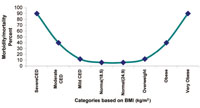5.4.1 Measurements of fat-mass (fatness)
As you read earlier Body Mass Index (BMI) is the weight of a person in kilograms divided by their height in metres squared. A non-pregnant adult is considered to have a normal BMI when it falls between 18.5 and 25 kg/m2. Table 5.2 shows you the different categories of nutritional status based on a person’s BMI.
| BMI(Kg/m2) cut-offs | Nutritional status |
|---|---|
| more than 40.0 | Very obese |
| 30.0-40.0 | Obese |
| 25-29.9 | Overweight |
| 18.5-24.9 | Normal |
| 17-18.49 | Mild chronic energy deficiency |
| 16-16.9 | Moderate chronic energy deficiency |
| less than 16.0 | Severe chronic energy deficiency |
If an adult person has a BMI of less than 16 kg/m2 they will not be able to do much physical work because they will have very poor energy stores. In addition they will be at increased risk of infection due to impaired immunity.
Risk of mortality and morbidity is related to the nutritional status as assessed by the BMI. If people are too fat or too thin their health suffers. The risk of mortality and morbidity increases with a decrease in the BMI. Similarly, when the BMI increases to over 25 kg/m2, the risk of mortality and morbidity increases. The relationship between BMI and risk of morbidity and mortality is shown in Figure 5.6.
What are the problem associated with having high (greater than 25kg/m2) or low (less than 18.5 kg/m2) BMI?
The risk of mortality and morbidity increases with a decrease in the body mass index. Similarly, when the body mass index increases over 25 kg/m2, the risk of mortality and morbidity as well as other diseases such as hypertension, diabetes mellitus and cancer also increases.
5.4 Anthropometric measurements used to assess body composition

